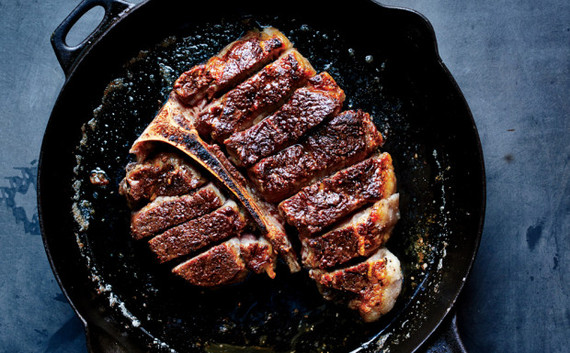BY ROCHELLE BILOW, BON APPETIT
In addition to eating healthier, the start of a new year is a great excuse for decluttering, spiffing up, and organizing your workspace. All week long, we'll be giving you tips for making sense of the most important room of the house: the kitchen. Welcome to Clean Sweep.
No piece of kitchen equipment incites such feelings of fear and anxiety (but also love and obsession) as the cast-iron pan. If you haven't mastered the art of cooking with--and cleaning--it, you probably fall into two camps: Either you gave up and let it rusty, crusty, and dusty, (this is starting to sound like a country music song), or you use it regularly but find that your food sticks to the pan due to improper seasoning. Enough already. Today is the day you learn how to season that pan properly from this day forward--because once you do, you'll have it for life.
If It's In Generally Good Shape...
Wipe It Clean
Every time you use your cast-iron, you should wipe out any bits of food. Sometimes, that just means a quick swipe (keep a rag or old towel near your stove exclusively for this purpose). For stubborn pieces and crusted-on crumbs, scour it with kosher salt and your rag. If it's really nasty, you can use a little warm water, but steer clear of the soap. And don't you dare put the pan in the dishwasher. Ever.
Lubricate the Entire Pan
Once the pan is clean, use your rag or a paper towel to coat it with a thin layer of fat. The type of fat doesn't matter: Olive oil, lard, coconut oil, vegetable oil, canola oil... it's all fair game. The important thing is to coat the entire pan with fat, and yes, that means the exterior, bottom, and sides of the pan. Explains Mark Kelly, public relations manager at Lodge Cast Iron, "Rust is like a virus that can spread from anywhere on the pan." That film of fat is what acts as a barrier against rust and decay, so lube up.
Gently Heat It
After that, place it in an oven set to 200-250 degrees for 15 minutes and let it cool down before storing it in a cabinet or on the stovetop. Be sure not to leave it in the oven--you'll likely forget it's there the next time you use it, causing it to overheat at higher temperatures. Some manufacturers (like Lodge) come pre-seasoned, and are technically ready to start cooking with right away. But for vintage cookware you should give it a good base seasoning you use it. After that, there's no need to go big unless you really muck it up.
If It's All Sorts of Gnarly...
Scrub the Rust and Crusty Bits Away
First, pay your penance. Kelly suggests using a piece of well-oiled steel wool to scrub at the crusted-on bits. You can also use warm water to help remove the really stubborn stuff. Steel wool will also help get rid of rust (for more tips on removing rust, check out this article). Be sure the pan is perfectly clean before proceeding.
Wipe It Down and Oil It Up
Use whatever fat you have handy, but it should have a smoke point that's higher than 350˚. Preheat your oven to that temperature and rub the pan generously with oil (but not so much that it's dripping like mad). Kelly likes vegetable oil-based Crisco, but lard, avocado oil, canola oil, etc., will all work. Don't forget the exterior of the pan.
Bake It
Line the bottom rack of your oven with a large sheet of aluminum foil to catch any drips, then turn the pan upside-down on the rack above the foil. Bake it at 350˚ for one hour, then turn off the oven and let the pan cool completely in the oven. After that, you're ready to cook. Just promise us that you'll clean and season it well after every single use.
One Last Thing...
Never, ever, ever put a cast-iron pan in a dishwasher.
More from Bon Appetit:

